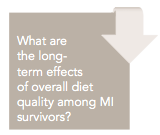Better Diet Leads to Reduced Mortality Post MI
What are the long-term effects of overall diet quality among myocardial infarction survivors?

Rabab Mohsin, MD
Review
JAMA Intern Med
Li S, Chiuve S, Flint A, et al. Better diet quality and decreased mortality among myocardial infarction survivors. . 2013;173:1808-1819.

“Would you like an MI with that?” If only the workers at fast food restaurants would ask this particular question, we might be able to motivate patients to improve their health and diet with actual lifestyle changes. The American College of Cardiology/American Heart Association (ACC/AHA) and multiple other medical governing bodies have provided great detail about the need to improve diet among myocardial infarction (MI) survivors, and physicians and nurses everywhere discuss eating habits and physical activity with MI patients prior to discharge. Now that the Joint Commission has advocated Recommended Core Measures for patient care, and hospital policy seems to be changing and a greater effort has been made to implement improvements in educating our patients about secondary prevention. Li et al state that close to 80,000 lives per year could be saved with optimization of secondary prevention—a figure that includes eliminating smoking and increasing physical activity. The recent 2013 ACC/AHA STEMI guidelines, however, did not mention specific dietary or caloric intake guidelines. The newest ACC/AHA literature actually refers back to older updates from 2007 and 2011 on the ACC/AHA Secondary Prevention and Risk Reduction Therapy for Cardiovascular Disease Guideline.1
Circulation
Research has shown since the early 1990s that improving diet and promoting better-quality foods improves secondary prevention and reduces cardiac risk factors. Particular diets have also been investigated to find which had the best results with respect to reduced rates of MI, for example, the Lyon Diet Heart Study. Published in in 19992 by de Lorgeril et al, it showed that there was a “protective effect” of the Mediterranean diet compared with the typical Western diet if it was maintained up to 4 years post MI.
The composite score used in the Li et al study is the Alternative Healthy Eating Index 2010 (AHEI2010). The AHEI was originally created in 2002 and is based on foods and nutrients predictive of chronic disease risk. AHEI2010 evolved from the Dietary Guidelines for Americans, which is a science-based outline that aims to reduce chronic disease in the United States and promote individual good health, last published in 2005.3 The AHEI2010 has 11 components including vegetables (excluding potatoes), whole fruits, whole grain, sugar-sweetened beverages and fruit juice, nuts and legumes (including tofu), red or processed meat, trans fat (partial hydrogenated vegetable oil in margarine or shortening), long-chain fatty acids (fish), polyunsaturated fats, sodium, and finally alcohol. The AHEI2010 score gives a detailed description of ideal servings per day and the exact quantity and type of serving per component. For example, 4 servings per day of whole fruit is thought to be ideal. One serving is 1 medium piece of fruit or ½ cup of berries.3
Higher scores on the AHEI-2010 were associated with a 19% lower risk of chronic disease, a 31% lower risk of coronary heart disease, and a 33% lower risk of diabetes.3 In addition, there were differences noted in men’s and women’s dietary profiles. Although the clinical presentation and cardiac risk factors for coronary heart disease do vary slightly for men and women, preventive strategies do not play a role, according to most current literature. Mosca points out that for women and men, coronary heart disease is the largest contributor to cardiovascular morbidity and mortality, and in 2007, women accounted for 60.6% of US stroke deaths.4 Furthermore, Mosca et al conclude that more men are living with and dying of coronary heart disease and have more hospital discharges for cardiovascular disease.4
The objective goal for Li et al was to examine the long-term effects of overall diet quality among MI survivors. In previous studies, the diets for patients with known coronary artery disease are at a focal point in time and do not describe the change or improvement in diet quality pre- and post MI. Thus, the Li et al study will be able to demonstrate improvement in prognosis due to dietary changes in MI survivors.
Study Details
Li et al designed a challenging and comprehensive analysis for determining the long-term effects of a high-quality diet in reducing mortality in patients with MI. The Alternative Healthy Eating Index 2010 was scored pre- and post MI. Two large prospective cohort studies were reviewed, the Nurses’ Health Study from 1976 and the Health Professionals Follow-Up Study from 1986. The Nurses’ Health study followed 121,700 registered female nurses. The present study included 2258 women from the Nurses’ Health Study who reported pre- and post MI diet. The Health Professionals Follow-Up Study is a cohort of 51,529 male health professionals; however, only 1840 men from that study were included in the present investigation by Li et al. Participants answered questionnaires every 4 years to assess the food frequency as determined by the AHEI2010 on a component score and an adherence score. Cardiovascular mortality included fatal coronary heart disease and fatal stroke.
P
The participants were selected if they were free of cardiovascular disease, stroke, or cancer. They had to have survived to the follow-up appointment after the initial MI. In women, there were a total of 682 all-cause deaths and 336 cardiovascular deaths. For men, there were 451 all-cause deaths and 222 cardiovascular deaths. Men had a greater improvement in diet quality compared with women after an MI. However, a higher AHEI2010 score had more significance in determining lower all-cause mortality in women than in men. Increased consumption of whole grains was associated with better post MI survival in women (<.001).
AHEI2010 scores post MI were associated with 24% lower all-cause mortality. Of the 11 components that comprise the score, sweetened beverages and fruit juice had the lowest component score (worse diet quality). A reduction of fats was the greatest trend seen among MI survivors. The authors conclude that a Mediterranean-style diet, which shares components of the AHEI2010 system, improves endothelial function and reduces inflammation in patients at risk for coronary artery disease. The gender differences noted in the study are quite profound. Women when younger have lower risk of MI but worse overall prognosis after MI, according to the study authors. Also, it should be noted that moderate alcohol consumption, which was double in men versus women, is a component of AHEI2010 scores and is associated with lower all-cause death and cardiovascular mortality.
Commentary Do a Better Job of Encouraging Patients to Improve Diet for Secondary Prevention
The use of secondary prevention strategies and education post MI have improved drastically in the past few decades. The public has shown more interest in popular weight loss programs. Due to the increase in diabetes and obesity occurring nationally, the ACC and other health governing bodies have undertaken mass public awareness campaigns about preventing cardiovascular disease. However, the change resulting from following preventive pre-MI and post MI diet plans has not been studied in detail previously. It is important to note that the Cox regression model and complicated statistical analysis used in the Li et al study tries to eliminate confounding data such as self-reporting bias; however, some confounders are still likely present.
The New England Journal of Medicine
The PREDIMED (Prevención con Dieta Mediterránea) study, a 2013 multicenter, randomized trial in Spain published in , found that the Mediterranean diet supplemented with extra-virgin olive oil or nuts reduced the incidence of major cardiovascular events.5 Adherence to this particular diet has been shown in many cohort studies to be associated with a better cardiovascular prognosis. In the Lyon Diet Heart Study, de Lorgeril et al showed a reduction in the rate of coronary heart disease with a modified Mediterranean diet enriched with alpha-linolenic acid (found in walnuts).2,5 In the study by Li et al there were gender differences between the components of the AEHI2010 that were stronger for women. Men had more total energy and calorie intake as well as more marked consumption of alcohol. However, the change in fruit and vegetable intake improved for both men and women over time after initial MI. To reduce confounders, the analysis corrected for age, smoking, and physical activity. However, the authors note that compliance with cardiac medications was not corrected for in the multivariate analysis. Li et al theorize that the gender differences are likely due to progression and prognostic differences of coronary heart disease between men and women.
The patient population in this study was predominantly Caucasian, well educated, and of a moderately high socioeconomic class. However, the INTERHEART study showed that secondary prevention principles used in multiple populations in 52 countries have the potential to prevent most premature cases of myocardial infarction.6 Yusuf et al found the highest percentage of first-time MIs in men 40 years or younger from the Middle East, Africa, then South Asia—12.6%, 10.9%, and 9.7%, respectively.6 Protective factors in the INTERHEART study included daily consumption of vegetables and fruit, strenuous physical activity, and alcohol intake 3 or more times a week.6 INTERHEART does show that across psychosocial factors including gender, ethnicity, and cultural differences, prevention of coronary heart disease has similar protective factors and predictors of mortality.
Other limitations that should be mentioned with respect to the Li et al study include medication compliance and the underlying severity of heart disease with routine follow-up with patients’ physicians. Overall, however, the structured analysis and the long-term follow-up are strengths for this study. The study’s evidence shows that improvement in diet quality and changes from pre-MI to post MI lifestyle reduces mortality. As physicians, we must engage in an ongoing, detailed discussion with patients post MI about the importance of compliance with medical recommendations. Improvement in diet quality reduces all-cause mortality and should thus be acknowledged to have an important role in preventing heart disease.
References
Circulation.
1. Smith SC, Benjamin EJ, Bonow RO, et al. AHA/ACCF Secondary Prevention and Risk Reduction Therapy for Patients With Coronary and Other Atherosclerotic Vascular Disease: 2011 Update: a guideline from the American Heart Association and American College of Cardiology Foundation. 2011;124:2458-2473.
Circulation.
2. de Lorgeril M, Salen P, Martin JL. Monjaud I, Delaye J, Mamelle N. Mediterranean diet, traditional risk factors, and the rate of cardiovascular complications after myocardial infarction: final report of the Lyon diet heart study. 1999;99:779-785.
J Nutrition
3. Chiuve S, Fung TT, Rimm EB, et al. Alternative dietary indices both strongly predict risk of chronic disease. . 2012:142:1009-1018.
Circulation.
4. Mosca L, Barrett-Connor E, Kass Wenger N. Sex/gender differences in cardiovascular disease prevention: what a difference a decade makes. 2011;124:2145-2154.
N Engl J Med
5. Estruch R, Ros E, Salas-Salvado J, et al. Primary prevention of cardiovascular disease with a Mediterranean diet. . 2013;368:1279-1290.
Lancet
6. Salim Y, Hawken S, Ounpuu S, et al. Effect of potentially modifiable risk factors associated with myocardial infarction in 52 countries (the INTERHEART study): case-control study. . 2004;364:937-952.
About the Author
R
abab
M
ohsin
, MD,
is a Cardiology Fellow at Texas Tech Medical Center in El Paso, Texas. She is board certified in Internal Medicine. Dr Mohsin received her MD from Ross University School of Medicine, Dominica, West Indies, and completed a residency in internal medicine at University of Kentucky in Lexington, where she participated in cardiac research protocols. She has published multiple abstracts on atrial fibrillation, obesity, and anticoagulation.
